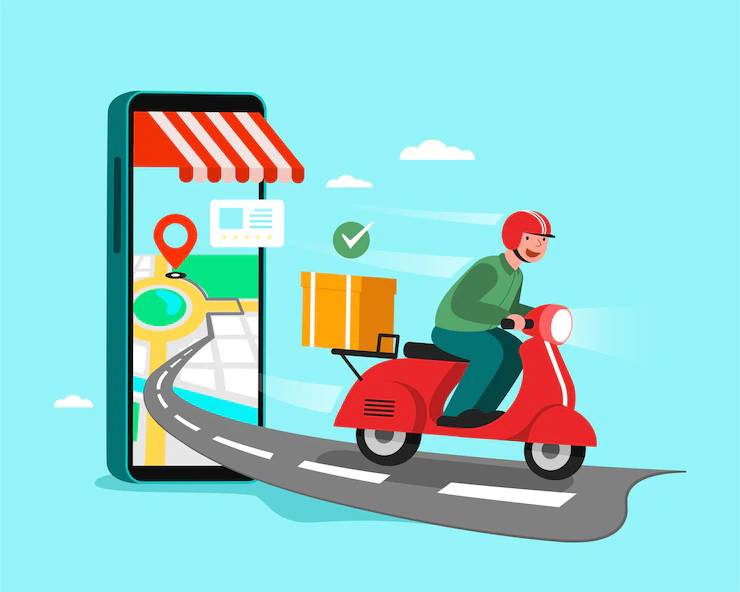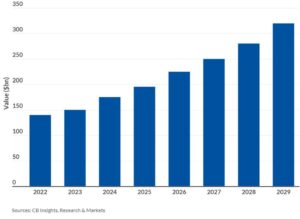According to a report by Business Insider, the food delivery business was among the list of most growing industries in 2020, and it has not looked back since then. If you are a restaurant owner or associated with the food industry, it is high time to invest your money in food delivery app development to get a share of this vast market.
In this article, we will be emphasizing the need to invest in this industry along with essential tips and tricks that you need to consider to compete with big market players such as GrubHub and UberEats. Moreover, we will be guiding you about the necessary features and cost estimation for your food delivery app development.
Importance of Food Delivery App Development in the Post-Covid Period
Although covid has seriously created an impact on almost every sector of business negatively, some industries are benefited from the pandemic, and the food delivery sector is one of them. This industry has seen a massive spike in recent years; look at the following statistics to understand the importance of this sector:
- 23% of people said they would only order for delivery or pickup for the rest of 2020. Do not forget to mention that this trend was not a fad!
- 60% of people in the U.S order delivery or takeaway at least once a week.
- Researchers anticipate that the food delivery industry will rise to $320 billion by 2029.
If these statistics do not persuade you to hire a food delivery app development company for your next app, what will?
So if you are interested in the food delivery business, learn who could be your potential competitors.
Top Players in Food Delivery Industry
DashDoor
DashDoor is one of the most widely used food delivery apps in the U.S. In 2020, its revenue grew from $850 million to $2.9 billion, projecting an extraordinary increase of 241%.
DashDoor currently comprises 57% of the total market share of Food Delivery apps in the U.S, increasing from 45% in 2020.
Furthermore, the majority of DoorDash users belong to the U.S (over 80 million). Its operations are spread over 7000 cities across the U.S, Canada, Australia, and Japan.
UberEats
UberEats is the most widely used app globally; its revenue exceeded $30.2 million in the year 2020. UberEats experienced a hike in revenue in 2020, thus increasing by 152%. Resultantly growing from $1.90 billion to $4.8 billion.
Currently, UberEats stands at a market share of 29%. Increased by 4% from 22% (FY20).
According to WSJ, UberEats has been valued at $20 billion while its parent company Uber Technologies Inc., stands at a massive valuation of $120 billion.
As per WSJ, UberEats has been valued at $20 billion, and its parent company Uber Technologies Inc., at $120 billion. The monthly average number of users of UberEats is estimated to be around 66 million, with each customer spending over $220.37 per month.
Grubhub
In 2013, GrubHub merged with Seamless, which increased its revenue three times. It generated a revenue of $1.8 billion in 2020, an increment of 39%.
In 2020, $8.7 billion worth of food was sold through Grubhub. Furthermore, it had 31.4 million active users. In 2020, the company was valued at $7.1 billion, which is way more than its valuation of $12.3 billion in 2018.
Moreover, GrubHub is currently active in over 4000 cities, along with the association with 256k restaurants, with chief operations in the U.S.
Different Models of Food Delivery App
If you want to develop an on-demand food delivery app, you first need to understand the different types of food delivery apps available in the market. Let’s have a look at them below:
1. Order Only Model
In this type of food delivery application, the app acts as a platform to link restaurants with customers. Using this app, customers can place orders at a restaurant of their choice. Restaurants benefit so that they do not have to make any extra effort to promote their business. They just have to register at the app and let customers order at their favorite restaurant.
2. Order & Delivery Model
This model is incredibly beneficial for newbie restaurants that do not have enough resources to cater to their delivery needs. It brings many benefits from the restaurants’ point of view because the adaption of this model eliminates the need for personnel, vehicles, and managing the delivery system.
Rather than just ordering, this app also provides the riders and delivery system. The app owner is responsible from picking food from restaurants to delivering it to the customer.
3. Fully Integrated Model
This model of food delivery app development goes a bit far. Hence, in this type of app, the app owner takes responsibility for everything from food preparation to picking food to delivering it to the customer’s doorstep.
Also, it is a comprehensive and integrated system where the app owns a kitchen or they enter into a partnership agreement with the food manufacturer. The customer just has to select the food they want to eat, and the food will be delivered to them—all at the responsibility of the food delivery app.
Depending on the needs and requirements, you can select the model of your choice.
Crucial Features to Consider During Food Delivery App Development
Merely developing a food delivery app is not sufficient. You have to create an entire ecosystem for the platform that works with all the parties involved.
Generally, a food delivery app has the following four parts:
1. Client Application
Customers can browse menus and order food from different restaurants using iOS or Android devices.
2. Restaurant Application
Customers view and manage their orders in this app.
3. Courier Application
This app involves the logistics party, i.e., the courier. They see the order status and shipping address.
4. Admin Panel
The owner, management, and the development team have access to this app. In addition, they add or remove restaurants, manage payment processes, and more.
Average Cost of an On-Demand Food Delivery App Development
The cost of development of a successful food delivery app such as UberEats and GrubHub depends on many factors, such as the features you want to add to your on-demand food delivery app and the time duration of the project specified by the Food Delivery App Development Company. Moreover, the resources required to move your app idea to a successful launch may fall somewhere around $30,000 to $40,000.
This cost quoted by an on-demand food delivery app development company should include:
- Mobile app design
- Android and iOS version development of the app
- App testing
- Launching the app in the market
Furthermore, if there is a need to develop a web application for restaurants, you can expect a raise in the range to $50,000-$60,000.
Ending Notes
In the article above, we have covered almost everything you need to know to enter the market of on-demand food delivery apps, along with the estimated cost. Now is the time for you to roll your sleeves and convert that idea into a successful app launch.
Finally, there is a vast potential market in food delivery apps that you can get a share of. This is only possible if you know what lies ahead in the food delivery app market. Furthermore, it places you in a better position to talk to your food delivery app development company.


